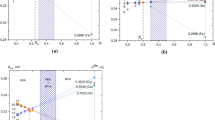A mathematical model and a software program (FLUOR81) were developed to implement the fundamental parameter method for X-ray fluorescence analysis of new alloy types. The model takes into account the X-ray tube excitation by polychromatic radiation and the secondary excitation of some elements by others. The program was tested using state standard samples of steels and alloys with nickel and cobalt matrices to show that the intensity of characteristic lines could be calibrated using pure elements in the absence of standard samples. In this case, the relative measurement error was no more than 3–4%. This approach was employed for mathematical modeling of the mutual influence of elements in the AlCrFeCoNiCu high-entropy alloy (HEA). The stoichiometric coefficients in the AlCrxFeCoxNixCu alloy were varied (x = 0.5, 1, 2) to find that the relative deviations of initial concentrations of components (ignoring their mutual influence) from the stoichiometric values were within ±50% and slightly changed with concentration. These patterns can be used for semiquantitative estimates of the HEA compositions for which no standard samples are available. To obtain results with a relative error of 3–4%, calculations with the software developed are needed.


Similar content being viewed by others
References
Ming-Hung Tsai and Jien-Wei Yeh, “High-entropy alloys: a critical review,” Mater. Res. Lett., 2, No. 3, 107–123 (2014).
Woei-Ren Wang, Wei-Lin Wang, Shang-Chih Wang, Yi-Chia Tsai, Chun-Hui Lai, and Jien-Wei Yeh, “Effects of Al addition on the microstructure and mechanical property of AlxCoCrFeNi high-entropy alloys,” Intermetallics, 26, 44–51 (2012).
B. Beckhoff, B. Kanngießer, N. Langhoff, R. Wedell, and H. Wolff, Handbook of Practical X-Ray Fluorescence Analysis, Springer Science Business Media, Berlin (2007), p. 863.
V.D. Kurochkin, L.F. Kravchenko, and L.M. Kuz’menko, “Structural effects in determining silicon concentration in Al–Si alloys by X-ray fluorescence and mass spectrometry,” Powder Metall. Met. Ceram., 44, No. 3–4, 191–195 (2005).
H.A. Sprang, “Fundamental parameter method in XRF spectrometry,” in: Advances in X-Ray Analysis, JCPDS-International Centre for Diffraction Data (2000), Vol. 42.
D.W. Burns, M. Wright, and S.O. Yusuf, “Evaluation of fundamental parameters for quantitative X-ray fluorescence of polyolefins,” in: Advances in X-Ray Analysis, JCPDS-International Centre for Diffraction Data (2014), Vol. 57.
H. Erhardt, X-Ray Fluorescence Analysis [in German], VEB Deutscher Verlag für Grundstoffindustrie, Leipzig (1980), p. 336.
M.A. Blokhin and I.G. Shveitser, X-Ray Spectrometry Handbook [in Russian], Nauka, Moscow (1982), p. 376.
M. Kurahashi, J. Mizutani, and A. Hioki, “Determination of trace elements in sediment reference materials by monochromatic X-ray excitation X-ray fluorescence spectrometry,” Anal. Sci. Jpn. Soc. Anal. Chem., 21, 827–832 (2005).
P.A. Verkhovodov, X-Ray Spectrometry. Theoretical Issues and Unification Methods [in Russian], Naukova Dumka, Kyiv (1984), p. 160.
Author information
Authors and Affiliations
Corresponding author
Additional information
Translated from Poroshkova Metallurgiya, Vol. 59, Nos. 1–2 (531), pp. 150–160, 2020.
Rights and permissions
About this article
Cite this article
Kurochkin, V., Romanenko, O. & Pukh, V. Mathematical Modeling of Mutually Influencing Elements by the Fundamental Parameter Method for X-Ray Fluorescence Analysis of High-Entropy AlCrFeCoNiCu Alloy. Powder Metall Met Ceram 59, 113–120 (2020). https://doi.org/10.1007/s11106-020-00143-8
Received:
Published:
Issue Date:
DOI: https://doi.org/10.1007/s11106-020-00143-8




